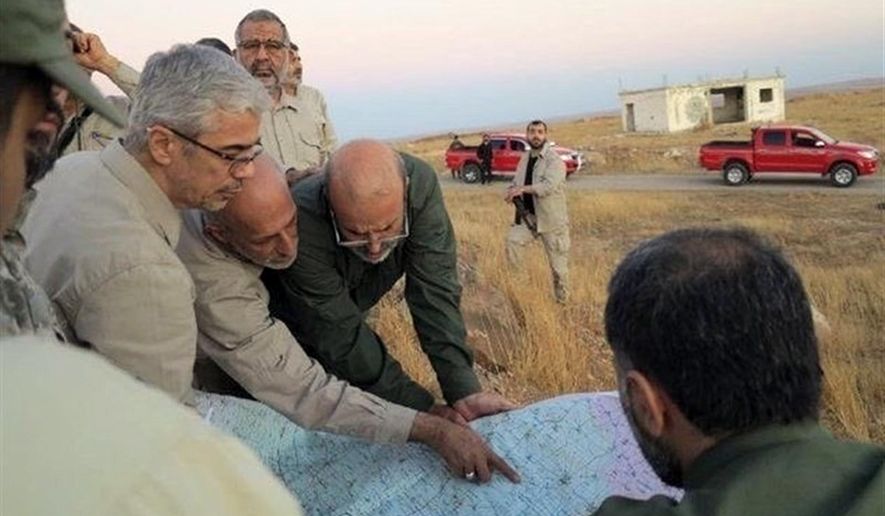A report from Iranian dissidents shows how the hard-line Islamic regime places terrorist operatives abroad under the cover of diplomacy.
From Austria to Albania to Iraq, an expansionist Iran has turned embassies into terrorism planning sites to meddle in host governments and hunt down the opposition, according to the report by the National Council of Resistance of Iran. The coalition includes the activist chapter known as MEK, which operates far-flung spy networks in Iran.
The report, “Iran Doubles Down on Terror and Turmoil,” presents a big-picture assessment of Iran’s foreign interventions in Iraq, Syria, Lebanon and Yemen, and its terrorism-sponsored plots in Europe.
“The mullahs’ regime has funneled billions of dollars to finance its belligerent war agenda in the Middle East while the majority of Iran’s people are living in poverty,” the report states. “As the regime’s officials have conceded, if the regime fails to inflame wars outside Iran’s borders, it would have to fight for survival within Iran’s borders. This is because external conflicts draw attention away from domestic crises.”
The National Council’s 57-page report contains the tale of ruling Muslim mullahs on the march, unleashing abroad a number of state organs and paid militiamen to wage war. They include: the Islamic Revolutionary Guard Corps, Iran’s dominant security apparatus; the Quds Force, a committed band of paramilitary foreign provocateurs; the Ministry of Intelligence and Security (MOIS) and its operations arm, the Organization for Foreign Intelligence and Movements (OFIM).
In Syria alone, the Revolutionary Guard controls as many as 100,000 troops. The Iranians fight alongside forces of Syrian President Bashar Assad, who the U.S. says has killed thousands of innocent civilians to stay in power.
Some council examples of Iranian “diplomats”:
⦁ Assadollah Assadi. Stationed at the Iranian Embassy in Vienna as a “counselor,” Mr. Assadi is an expert in explosives and played a “decisive role” in killing American forces in Iraq from 2004 to 2008. European authorities arrested Mr. Assadi in July for masterminding a thwarted car-bomb attack on a huge gathering of National Council members near Paris.
MOIS has made the Vienna embassy its hub for orchestrating attacks on dissidents. A German court this month approved Mr. Assadi’s extradition to Belgium.
⦁ Gholamhossein Mohammadnia. The senior MOIS deputy became the Iranian ambassador to Albania in 2016.
Why is Albania important? That same year the MEK completed relocating its headquarters from Iraq to Tirana. The National Council says the embassy has since planned several missions against its members.
“The embassy increasingly came under the control of MOIS agents,” the National Council says.
⦁ Reza Amiri Moghadam. The head of MOIS’ operations unit, Mr. Moghadam has been deployed overseas as a “diplomat,” allowing him to meet with the U.S. ambassador in Iraq in 2007. MOIS agents in Europe report to him in Tehran.
“He is the key figure for the regime’s terrorist operations outside Iran, particularly in Europe and the U.S.,” the National Council’s report said.
⦁ Iraj Masjedi. The Iranian ambassador to Iraq is a veteran commander of the Quds Force, which orchestrated bombing attacks on U.S. troops. He is also a chief adviser to Maj. Gen. Qassem Soleimani, the Revolutionary Guard commander and dedicated U.S. foe. He controls various Shiite militias in Iraq, totaling 100,000. The Pentagon estimates that Iran helped anti-American Iraqis kill 500 U.S. troops with roadside bombs.
“All of the Iranian regime’s terrorist operations in Iraq were controlled and commanded by [Mr. Masjedi],” the Iranian opposition report said. “Under the guise of its ambassador, the regime has continued meddling in Iraq.”
Gen. Soleimani has made several visits to Iraq, the last believed to be in August.
“He is trying to threaten and intimidate various parties and groups to secure a larger share of power for the Iranian regime,” the National Council’s report said.
Iran’s biggest bet is on Syria, where it participated with Russia in the infamous 2016 rape of Aleppo, killing hundreds of civilians while conquering the besieged rebel stronghold.
The council estimates that Iran has pumped as much as $100 billion into Syria to build bases, pay troops and ship weapons.
Iran has divided the country into five war zones, including territory controlled by U.S.-backed anti-Assad fighters who liberated Raqqa and other towns from brutal Islamic State occupation.
In Iran, Gen. Soleimani controls fighters from Afghanistan, Pakistan and Iraq, along with its sponsored army, the Lebanese Hezbollah.
Since MEK set up its new home in Albania with 270 members, the National Council says, Iran has turned a bare-bones embassy of one or two personnel into “one of the most important Iranian embassies in Europe.”
The report states: “In 2017 Mostafa Roudaki, who had been in charge of the intelligence station in the regime’s embassy in Austria, became the head of station in Albania, and was tasked with increasing the espionage and terrorist activities against the MEK.”
In March, Albanian authorities arrested two Iranian agents who planned to set off a truck bomb at a Persian celebration, the report says.
• Rowan Scarborough can be reached at rscarborough@washingtontimes.com.




Please read our comment policy before commenting.